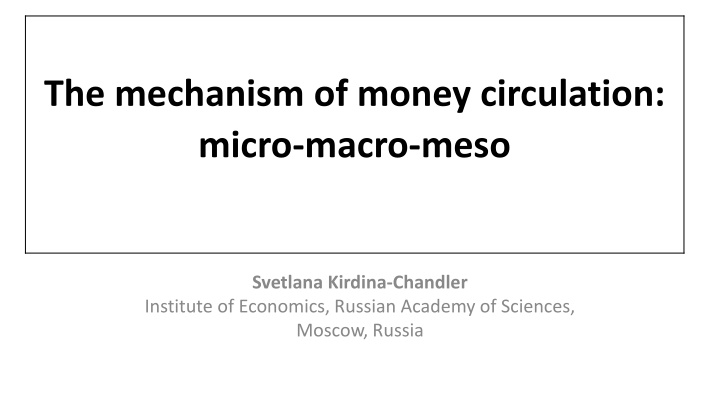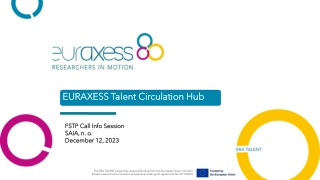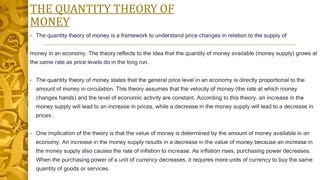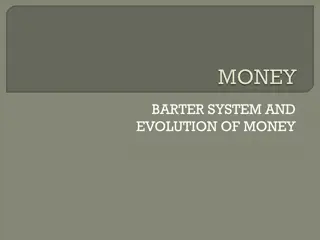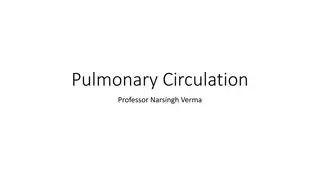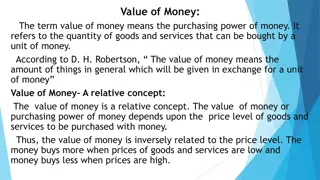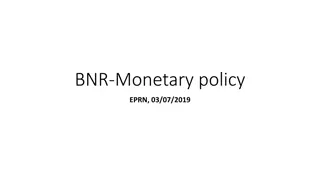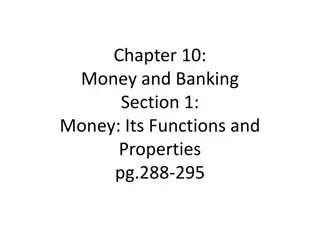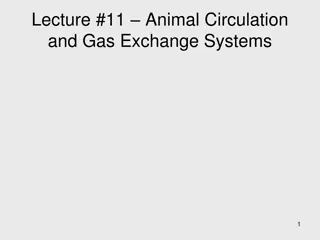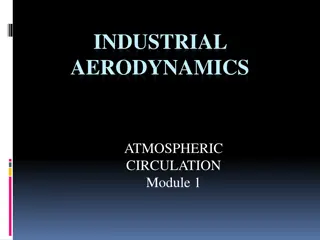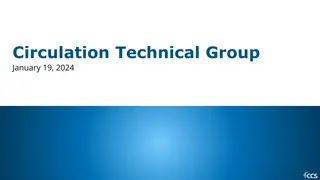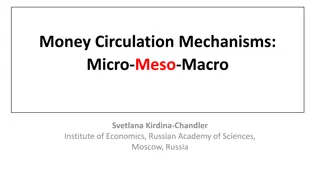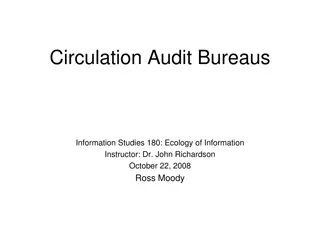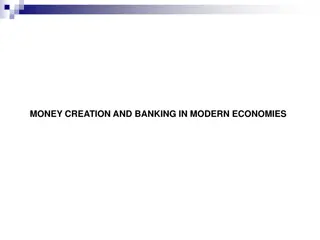Money Circulation Mechanisms in Economic Systems
The concept of money circulation and its impact on economic systems across different levels of analysis is explored through a mesoeconomic lens, emphasizing the importance of understanding transmission mechanisms. Long-term studies highlight variations in money circulation based on economic institutions, shedding light on the evolving nature of financial systems. The institutional perspective of money is investigated within methodological institutionalism, linking structural levels of economic theory to the sophistication of ideas surrounding money circulation analysis.
Download Presentation

Please find below an Image/Link to download the presentation.
The content on the website is provided AS IS for your information and personal use only. It may not be sold, licensed, or shared on other websites without obtaining consent from the author.If you encounter any issues during the download, it is possible that the publisher has removed the file from their server.
You are allowed to download the files provided on this website for personal or commercial use, subject to the condition that they are used lawfully. All files are the property of their respective owners.
The content on the website is provided AS IS for your information and personal use only. It may not be sold, licensed, or shared on other websites without obtaining consent from the author.
E N D
Presentation Transcript
The mechanism of money circulation: micro-macro-meso Svetlana Kirdina-Chandler Institute of Economics, Russian Academy of Sciences, Moscow, Russia
Who were the first? The idea of money circulation s mechanisms as the most important subject of mesoeconomic research was first outlined in the works of corresponding member of RAS Victor Dementiev and then articulated by academician RAN Vladimir Maevsky. Dementiev (2002). Theory of the economy mesoeconomic theory. Rossiysky ekonomicheskiy zhurnal, no. 4, pp. 71-82. V.E. MaevskyV. (2018). Mesolevel and hierarchical structure economy. of Institutional Studies, no. 3, pp.18-29. I. national and of Journal the vol. 10, 2 2019, Pushchino
Motivation-1 Monetisation of the economy (the ratio of broad money to nominal GDP) varies from 14.5 or 25.9% (Chad or the Central African Republic) to 199.1 or 252.1 (China or Japan); it is not related to economic growth. Therefore, it can be assumed that the mechanisms that ensure the circulation of money in the economic system are important. Therefore, such mechanisms must be studied. 3 2019, Pushchino
Motivation-2 Long-term studies on the theory of X and institutional matrices showed that the mechanisms of money circulation differ in countries with a dominance of X and Y economic institutions. Vernikov A.V. and Kirdina S.G. (2010). Evolution of banks in the X- and Y-economies. In: Evolutionary Economics and Finance: Innovation, Competition, Economic Growth. Materials of the VIII International Symposium on Evolutionary Economics, Pushchino, Moscow Region, Russia, September 17-19, 2009. Moscow: Institut ekonomiki RAS, pp. 246-280. (In Russian). Kirdina, S., Vernikov, A. (2013). Evolution of the Banking System in the Russian Context: An Institutional View. Journal of Economic Issues, vol. 47, no. 2, pp. 475-484. Kirdina S.G. (2013). Institutional Models of Real Sector Financing, Zhurnal Novoy ekonomicheskoy assotciatcii, no. 2 (18), pp. 129-157. (In Russian). Kirdina S.G. (2016). Institutional organization of economic reproduction in X- and Y- economies, Journal of Institutional Studies, vol. 8, no. 4, pp. 72-91. (In Russian). 2019, Pushchino 4
Outline The institution of money from the perspective of methodological institutionalism. Testing the hypothesis that the distinguish of structural levels of economic theory (microeconomics, macroeconomics and then mesoeconomics) can be associated with the introduction into economic analysis of increasingly sophisticated theoretical ideas about money circulation in the economic system. The specificity of the mesoeconomic approach to the analysis of money circulation in studying the characteristics of transmission mechanisms of money circulation. Conclusion and Discussion. 2019, Pushchino 5
Money as institution 2019, Pushchino 6
Methodological institutionalism We consistently adhere to the principle of methodological institutionalism (Kirdina, 2015) when highlighting the mesolevel in social and economic analysis Institutionality" of the mesolevel means its interpretation as a sphere of action of the rules of joint activity followed by individuals or groups of the micro level, which allows for the functioning of the entire system at the macro level. 2019, Pushchino 7
The main focus of analysis Study of the institutional design of economic relations, which ensures the whole economy to develop and provide the proportions necessary for its expanded reproduction in the conditions (spatial, temporal, technological, global-political, etc.) in which this economic system is located. The institutional environment is considered not so much from the point of view of ensuring the harmonisation of the interests of participants in economic activity (which is important, although almost unattainable), but primarily as an instrument, the existing structure of reproduction of the economic system. The institution of money and the mechanisms of money circulation under the mesoeconomic approach are supposed to be considered from this point of view. 2019, Pushchino 8
Our analysis of the money institution uncertainty of joint economic activity and creating certain expectations among its participants: if there were no uncertainty in the real world, the monetary system could not exist at all! (Rothbard, 2011. P. 36). The main types of uncertainty that characterise the process of economic reproduction is the measurement of products of different quality, but, more importantly, in the context we are considering, the comparison of the costs and results of economic activity at different periods of time and the creation of conditions for continuous renewal of economic system. From this point of view, the money institution and the mechanisms of money circulation inherent in it are functional-temporal structures. The money institution was formed with the aim of reducing the 2019, Pushchino 9
Money institution as a functional structure Money institution function is to ensure the commensurability of the most important proportions in economic processes and the translation (circulation) of the necessary information in the structures of the economic system. Money is a bunch of socially recognised information with independent value, information about the amount of value that business entities recognise in transactions related to goods and services ... (Surikov, 2015, p. 35), regardless of what kind of the economic system - market or redistributive, - these processes occur. 2019, Pushchino 10
Money institution as a temporal structure On the basis of money, a comparison of past, present and future labor is possible, the institution of money allows us to create the basis of accounting for present and expected future prices (Rothbard, 2011. P. 18). 2019, Pushchino 11
Preliminary summary In the mesoeconomic analysis, we focus on the objective nature of money circulation mechanisms, allowing them to fulfill their basic tasks of ensuring the reproduction of the economic system. 2019, Pushchino 12
The role of new ideas about money circulation to distinguish macroeconomics from microeconomics 2019, Pushchino 13
The paradox of thrift (paradox of saving) The fundamental difference between macroeconomics as a new level of economic analysis is that it implies the structure of the monetary mechanism in which public finances appear (in microeconomic models, money did not appear at all, Ingham, 2004. P. 8). The separation of a new level was associated with a more adequate representation of money circulation processes in the theoretical model of the economy, which began to include the transmission mechanism of monetary policy. Through these mechanisms, a change in the proportions of money affects business activity and economic equilibrium. 2019, Pushchino 14
The new theoretical model, involving the interaction of macro and micro levels, turned out to be very relevant, for example, to overcome the consequences of the Great Depression. After the Second World War, also macroeconomic regulation gave remarkably accurate and predictable results (Baumol, 2001. P. 101). https://www.google.ru/search?q=%D1%81%D0%BB%D0%BE%D0%B6%D0%BD%D0%BE%D1%81%D1%82%D1%8C&newwindow=1&source=lnms&tbm=isch&sa=X&ved=0ahUKEwit8PzyuN_YAhXKMywKHRKICVkQ _AUICigB&biw=1270&bih=564#imgrc=A8qFNHepA2DzNM 2019, Pushchino 15
Next step is needed However, further complication of the economic structure, new players entering the arena, and the development of financial mechanisms required the refinement of the theoretical model. The micro-macrostructural representation of the economy, being sufficiently effective for its time, in the new conditions turned out to be insufficiently heuristic, and operating only with the proportions of money entering the economy, without analysing how the money circulation inside the economy occurs, is insufficient. 2019, Pushchino 16
From macro- to mesoeconomic analysis of money circulation-1 Of course, in the modern monetary theory new transmission mechanisms are the subject of analysis. But based only on neo-classical macro- and microeconomic foundations, the notions of transmission mechanisms (among them money view, lending view & supply view) allow one to study changes in the real sector only in the short-term period of time under stationary conditions (Moiseev, 2002. P. 41- 42. As he noticed, monetarism sees the economy as a "black box" within which unknown processes take place. Thus, the transmission mechanism as such is absent, Moiseev, 2002. P. 45). But for modern economies with a complex structure that strongly deviate from the neoclassical model, a deeper analysis of the transmission mechanisms of money circulation is necessary, which attracts modern mesoeconomists to this subject (Mayevsky, 2018, p. 26). 2019, Pushchino 17
From macro- to mesoeconomic analysis of money circulation-2 The macroeconomic approach is poorly applicable for the analysis of new complex structures. Macroeconomic models are nonhistorical and do not contain anything that would distinguish market economies from Soviet-type economies or from the economies of Ancient Rome and medieval China (Baumol, 2001, p. 84). Economies differ primarily in (Dementiev, 2002, p. 72). Both market and non-market forms of coordination operate in them, nonequilibrium exchanges are possible, which determines the specifics of the more complex money mechanisms operating here, which occupy an intermediate position between the micro and macro levels of the economy. In this complex structures, money is not only (and not so much) the result of the issuance of central banks and state policy, but also is formed endogenously, due to banks and credit operations in financial markets. their meso-economic characteristics 2019, Pushchino 18
Conclusion and discussion 2019, Pushchino 20
The increasing complexity of the economic structure is reflected in the growth of the diversity of economic relations, which cannot be attributed to either the micro or macro level. We are talking about large corporations, about emerging alliances, about the development of clusters, about financial and industrial groups, platform markets, innovative systems and other structures in which hierarchical and horizontal forms of interaction coexist and complex monetary mechanisms for supporting their activities develop. In general, evolutionary and institutional theories, modeling, clusters, network structures, and all sorts of group associations may require their own theoretical space meso (Chen, 2008. P. 121), which has happened in recent years in economic theory. 2019, Pushchino 21
We also showed that the complication of ideas about the structure of the economy - from micro - to macro and then to meso - turns out to be connected with the inclusion of more developed money circulation schemes in theoretical economic models. As they say in the famous American phrase - follow the money, if you want to understand complicated things. The study of the mechanisms of money circulation in mesoeconomic studies can be a very promising direction for deepening our ideas about the structure of the modern economy. 2019, Pushchino 22
See more - . . (2019) // Journal of Institutional Studies. . 12. 3. (Kirdina-Chandler, s. (2019) Mechanism of money circulation as a subject of mesoeconomic analysis // Journal of Institutional Studies. Vol. 12. 3. In Russian). 2019, Pushchino 23
Thank you for your attention! ! kirdina777@gmail.com 2019, Pushchino 24
